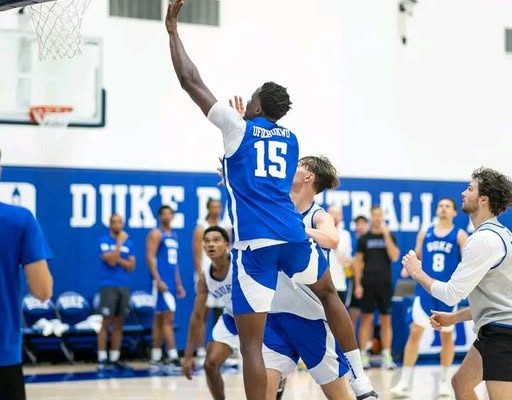Something’s different in Durham, and it’s not just the buzz in the air or the uptick in fan energy at Cameron Indoor Stadium. This isn’t about a breakout freshman or a top-ranked recruiting class finally living up to its potential. Insiders and longtime observers of Duke basketball are seeing a transformation that goes beyond talent. It’s a shift in the very way Duke approaches the game—specifically, how they practice.
For years, Duke’s basketball identity has been defined by its commitment to high basketball IQ, intense defense, and fast-paced offense. But over the past few seasons, cracks in that foundation became visible. The Blue Devils have looked good on paper but have fallen short in execution when it matters most. Tight games slipped away late. Defensive assignments broke down. The rhythm that once defined Duke’s play seemed disjointed.
This year, however, that narrative appears to be flipping. There is a cohesion, a sharpness, a kind of anticipatory movement on both ends of the floor that feels vintage yet new. The players look more connected. The rotations are tighter. The defensive communication is clearer. The offense flows with a smoother cadence. So what changed?
According to insiders close to the program, the answer lies in a fundamental change in practice strategy.
Duke’s coaching staff, led by Jon Scheyer, made a subtle but powerful shift over the summer. They began implementing more game-simulated practice scenarios instead of drilling traditional sets and repetitions. This means rather than spending excessive time on isolated skills or set plays, Duke now simulates in-game conditions with greater intensity and variability. Practices are faster, less predictable, and more oriented around problem-solving on the fly.
It might sound like a small adjustment, but the impact has been enormous. By turning practice into a pressure cooker of live decisions, rotations, switches, and counters, players are adapting to chaos. They’re learning to recognize patterns, anticipate changes, and make instinctual reads. It’s no longer about memorizing the next move; it’s about being ready for the one after that.
Insiders have also noted that the coaching staff is holding players more accountable during these sessions. Mistakes aren’t just corrected; they’re interrogated. Players are asked to explain what they saw, why they made a decision, and how they might respond differently. This active reflection is embedding situational awareness deep into their preparation. It’s not just about doing the right thing, but knowing why it’s the right thing.
Scheyer, now in his second full season as head coach, has embraced a more modern coaching philosophy—one that blends analytics, mental sharpness, and performance psychology. The influence of outside consultants and former Duke alumni currently in the NBA has also been significant. Many of these professionals advocate for high-rep, high-intensity decision-making scenarios as a way to sharpen court vision and communication. Duke has taken that philosophy and molded it into their own version, suited to the college game and the Blue Devils’ personnel.
Another major shift has been the restructuring of how players are grouped during drills. Instead of the traditional first-unit vs. second-unit model, Duke is now constantly rotating combinations of players. Veterans play alongside freshmen, guards work with bigs in two-man games, and wings are asked to run point in certain scrimmages. This cross-training method has not only improved individual versatility but also fostered trust and adaptability across the roster.
The early signs of success are undeniable. Duke’s defense, once vulnerable in transition and prone to breakdowns on switches, now looks synchronized. Guards are fighting through screens with more purpose. Forwards are hedging and recovering like clockwork. Weak-side help is arriving on time. Opposing teams are struggling to generate open looks against a Duke unit that seems to have eyes in the back of its head.
On offense, the same principles are taking root. Rather than relying heavily on isolations or predictable sets, the Blue Devils are spacing the floor more creatively. Off-ball movement is smarter, with backdoor cuts and elevator screens being deployed at just the right moments. The team is also more efficient in exploiting mismatches—not through brute force, but by leveraging angles, timing, and spacing.
It hasn’t gone unnoticed by the fanbase either. Attendance at practices and open sessions has surged. Students and alumni have taken to social media to comment on how “different” the team looks this year. Former players who have returned to Durham have echoed similar sentiments. There’s a fluidity, a harmony, and a resilience that hasn’t been as visible in recent years.
Even the players are talking about it. Several have mentioned that this year’s practices are the most demanding and rewarding they’ve ever experienced. Veteran guard Jeremy Roach recently stated, “We’re not just running drills. We’re competing, thinking, adjusting. Every practice feels like March.”
The culture around the program has also started to shift. There’s a stronger emphasis on leadership from within. Players are empowered to speak up, correct each other, and hold one another accountable. That leadership-by-committee approach is mirroring the way they play—connected, reactive, and dynamic.
Critically, this new practice approach has also begun to show its worth in crunch-time moments. Late in games, when fatigue sets in and mental sharpness fades, Duke has held strong. They’ve made fewer unforced errors. They’ve rotated with more urgency. Their composure under pressure suggests a team that has been there before, even if it’s only been in practice.
It’s worth noting that this isn’t a reinvention of Duke basketball, but rather a return to its deeper values with a 21st-century upgrade. The program’s commitment to excellence, development, and competitiveness hasn’t wavered. What’s new is the way they’re being trained to achieve it.
The Blue Devils aren’t just being drilled anymore—they’re being conditioned to thrive in uncertainty. And that may be the biggest weapon they carry into this season.
As tournament time draws closer and competition intensifies, this subtle shift in how Duke practices could be what sets them apart. It’s not the highlight-reel dunks or the five-star recruits. It’s the daily grind, the mindful repetition, the relentless focus on decision-making under duress. That’s what’s making Duke look like a completely new team.
So yes, something is absolutely different in Durham. And if this keeps up, the rest of college basketball might find itself chasing a Duke squad that’s not just back—but better than ever.



